Hexagon Purus sets roots in Kelowna, where it will design and build BEV battery packs and…a new truck?
Kelowna, B.C., birthplace to diesel-powered Western Star mining and logging trucks, is now the home to a state-of-the-art battery plant that will power battery-electric commercial trucks, including one that will carry the badge of the battery maker itself.
Hexagon Purus held an open house at its new battery engineering and production plant here April 19, attended by employees, local dignitaries, and guests from as far away as Norway, Germany, and Japan. The global producer of natural gas and hydrogen storage systems for the trucking industry has expanded into the production of battery packs, and chose Kelowna as its North American home for these activities.
The battery plant will be operated by Hexagon Purus, the Hexagon business unit focused on zero-emissions transport. (Not to be confused with sister company Hexagon Agility, maker of the natural gas and hydrogen fuel storage systems).
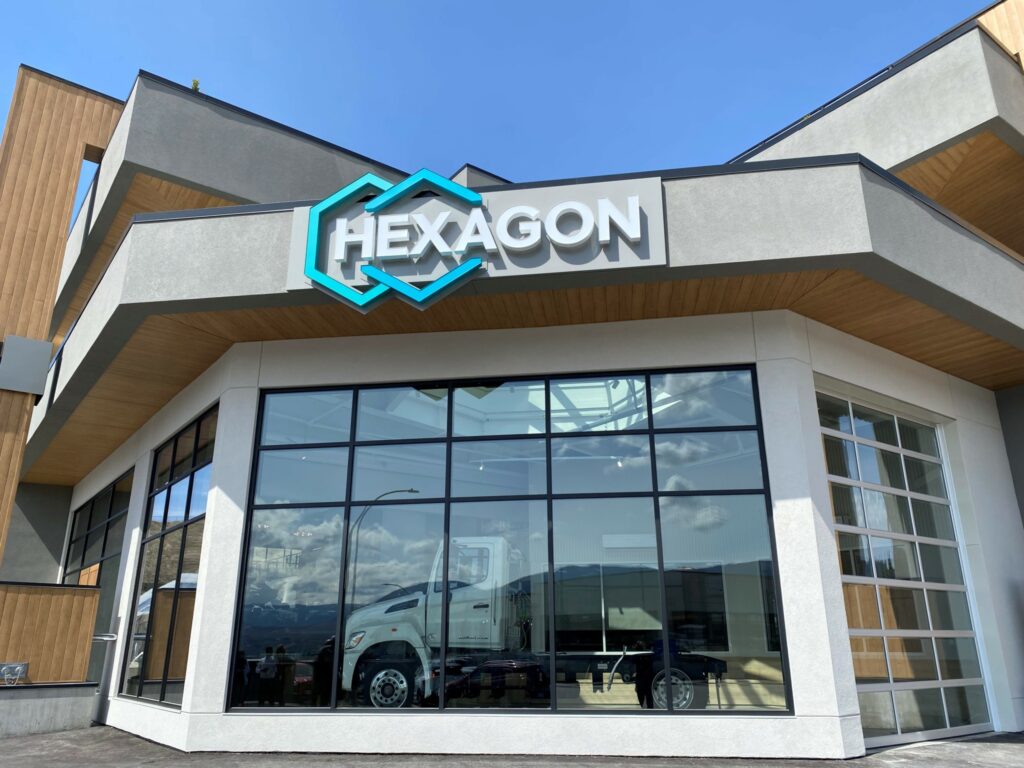
Why Kelowna?
Why Kelowna? The answer can be traced back to the presence here of Western Star, which was purchased by Daimler Trucks North America (DTNA) at the turn of the century, with production pulled out of Kelowna and moved to Portland, Ore. Despite that move more than two decades ago, the truck brand’s roots here run deep.
“If not for Western Star, we wouldn’t be here today,” said Todd Sloan, executive vice-president of Hexagon Purus, who was influential in bringing the business to Kelowna. The University of Victoria grad formerly worked for Northside Industries, supplying the Western Star plant with everything from fuel tanks, bumpers, cabs, and J-brackets. “I loved the trucking business and I was hooked,” he said in an interview with TruckNews.com.
Sloan went on to found Enviromech Industries, focused on developing hydrogen and natural gas fueling systems for trucks. That business merged with Agility Fuel Systems, which was eventually purchased by Hexagon, creating Hexagon Agility. Those relationships supplying natural gas storage systems to Western Star’s parent company DTNA led to Hexagon Purus’s first big breakthrough in the battery-electric space.
Sloan was in California in 2016, working on natural gas projects when he got wind of Freightliner’s pending development of an Innovation Fleet of battery-electric vehicles. Hexagon landed the battery supply deal for all 22 Freightliner eCascadias involved in the fleet, and seven of the nine eM2 medium-duty trucks.
“We did the full integration,” Sloan recalled.
It was a huge breakthrough for the company, acknowledged Hexagon Purus president and CEO Morten Holum. “You didn’t start with the small guys. You went straight to Daimler,” Holum said to Sloan during the presentation on a stage mounted on the chassis of a Freightliner eM2. “They’re known to be some of the most demanding customers you can have, with extreme quality and reliability requirements and zero tolerance for risk.”
The experience gained through Freightliner’s Innovation Fleet was vital in growing Hexagon’s battery business.
“The significance of the Innovation Fleet was, you got those batteries on live testing with customers early on,” Holum said in an interview. “It demonstrated this actually works quite well and you gain a lot of experience and get all that data. We have all this knowledge, and now you can improve what you have. You can now put it out to new customers and have experience that few other companies are having, then you’re able to stay ahead of the pack when it comes to the technology itself.”
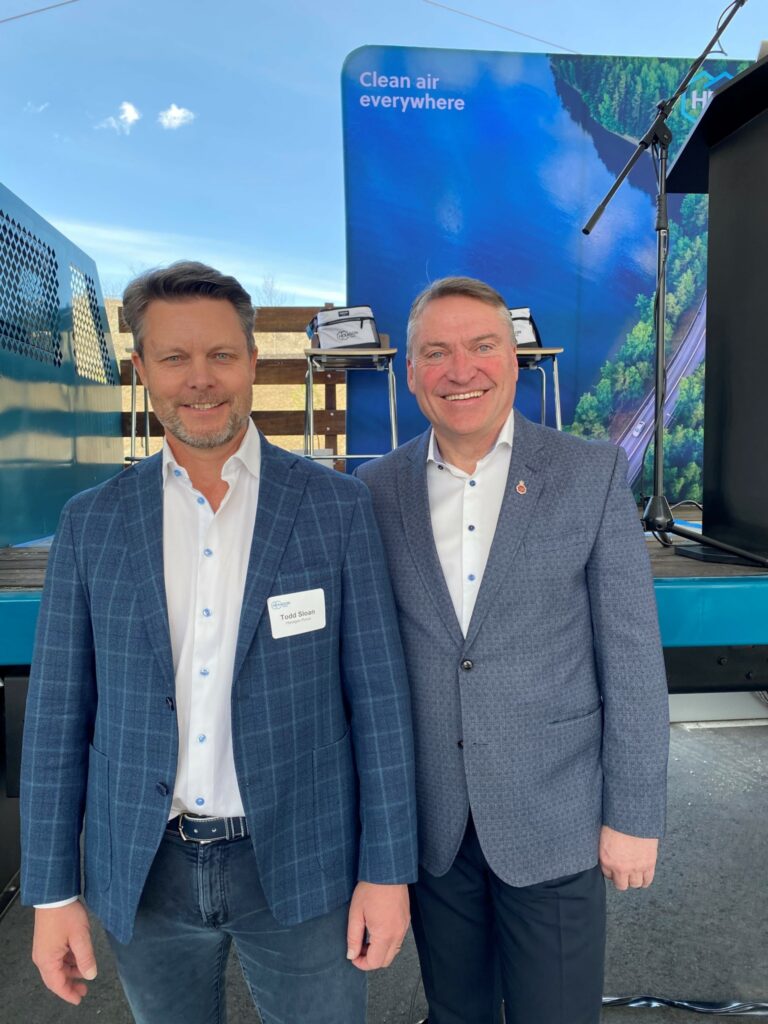
Hexagon Purus took those learnings, and was able to develop what it claims is now the lightest weight and most energy dense battery pack in the business. Sloan said one metric used to validate this claim is the kWh per meter of frame rail.
“We have the best metric in the industry in kWh per meter of frame rail length,” Sloan said. This allows for shorter wheelbases for improved maneuverability, and also gives more flexibility for body builders when installing equipment such as street sweepers and outriggers on vocational trucks.
To ramp up battery pack production, Hexagon first needed to secure a reliable supply of battery cells. It approached Panasonic, supplier to Tesla, and spent more than a year convincing the company to supply Hexagon.
“They’re very selective with who they work with,” Sloan explained, noting battery cell capacity can’t keep pace with demand. “They had to be convinced we’re a safe conduit of their technology. They don’t have a lot of customers, Tesla being the biggest.”
This supply deal with Panasonic in turn enabled Hexagon Purus to land a US$2-billion battery pack supply deal with Hino, extending to 2030 and ramping up to 2,000 trucks per year.
The battery packs built in Kelowna will be shipped to a Hexagon facility in the U.S. (site selection is being finalized) where they’ll be installed on the trucks themselves. Battery-electric production is currently at such low volumes, it’s disruptive for an OEM like Hino to install the packs on its own lines, which are still predominantly churning out diesel trucks.
Sold out
The Hino deal alone has assured Hexagon Purus its Kelowna site will remain busy through 2030.
“This factory is sold out,” Sloan said, noting initial plans to also produce hydrogen systems here have been shelved, with those now set to be produced at another Hexagon plant in Maryland. “In fact, in 2026 we’ll need two or three of these to keep up with the 2027 demand we expect.”
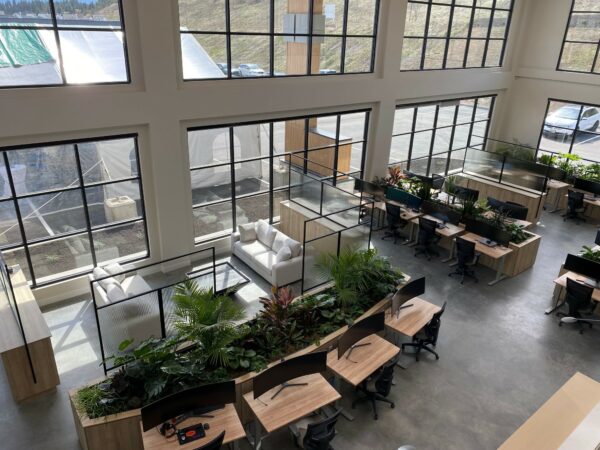
Added Holum: “I don’t think we’re going to be demand constrained in this business for the next 10 years, to be honest. It’s going to be supply constraints.”
For Sloan, it was personally gratifying to bring the burgeoning business to Kelowna, despite the logistical challenges in doing so. He admitted it was a tough sell.
“It’s not the greatest place to have a factory. Logistically, it’s quite horrible,” he said. But Holum was convinced because of the access to engineering talent, and the beauty of the area which made it appealing to talent pursuing a good work-life balance.
“It’s the competence we have here, the engineers we have here,” Holum said of the attraction. “It’s also a great place to live. When I look at this facility I see much less a manufacturing facility, and more of an engineering and design facility.”
The engineering and design areas overlooking the plant floor are outfitted with common work areas, couches, a games room and gym, and an expansive rooftop patio provides gorgeous vista views.
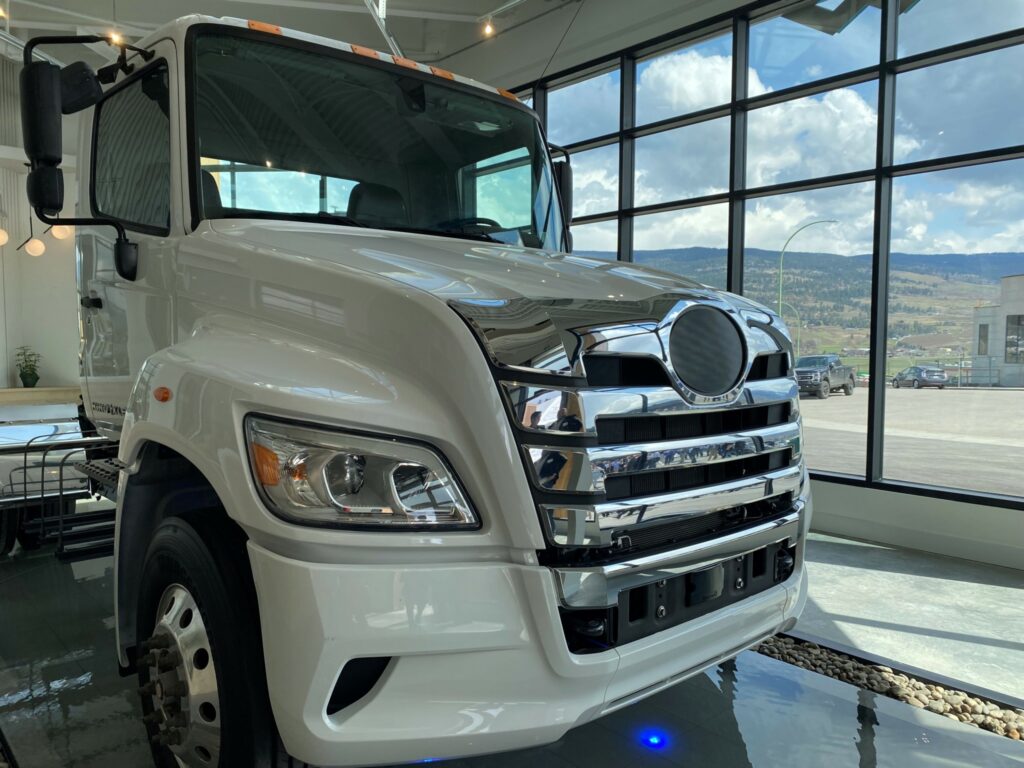
A Hexagon truck?
Back inside, sitting prominently in the lobby of Hexagon Purus’s new facility was a Hino truck, with its logo on the hood conspicuously blacked out. This was to tease a future Class 7/8 battery-electric truck, to be rolled out in the fourth quarter of 2024, that will be branded by Hexagon Purus itself.
“All the Hino branding is going to be removed from the truck,” Sloan said, noting the name of the truck has yet to be determined. “It will be a Hino rolling chassis with Hino cab, but no Hino branding anywhere. The emblem on the front will be removed and replaced with our brand. We will sell that through select Hino dealerships.”
The new truck – a Class 7/8 4×2 tractor with 264 or 528 kWh battery capacity (the most detail I could squeeze out of them) – will make its debut at next year’s ACT Expo show. With that truck launch, Kelowna will have come full circle as a truck production hotbed, from producing diesel Western Star trucks from 1967 to 2002, to the battery packs that will power the next generation of zero-emissions vehicles, including one that will carry the company’s own logo on the hood.
Have your say
This is a moderated forum. Comments will no longer be published unless they are accompanied by a first and last name and a verifiable email address. (Today's Trucking will not publish or share the email address.) Profane language and content deemed to be libelous, racist, or threatening in nature will not be published under any circumstances.
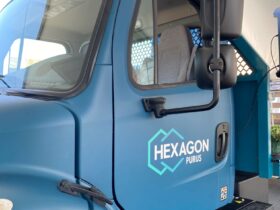
Electric Class 8 Trucks, definitely not for Me. Diesel is My choice, 500-600 hp backed by an 18 Speed manual. I’ve had a connection with White Western Star and later Western Star. Long gone from Kelowna but left its mark. The sound of the Diesel is in My Blood not a Silent Electric Work Horse, sorry not for this Old School Trucker of forty years.